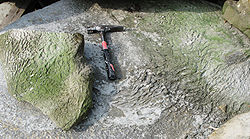
Microbially induced sedimentary structure
Encyclopedia

Sedimentary structures
Sedimentary structures are those structures formed during sediment deposition.Sedimentary structures such as cross bedding, graded bedding and ripple marks are utilized in stratigraphic studies to indicate original position of strata in geologically complex terrains and understand the depositional...
formed by the interaction of microbes with sediment and physical agents of erosion, deposition, transportation, or deformation traces of microbial activity . The structures commonly form when microbial mat
Microbial mat
A microbial mat is a multi-layered sheet of micro-organisms, mainly bacteria and archaea. Microbial mats grow at interfaces between different types of material, mostly on submerged or moist surfaces but a few survive in deserts. They colonize environments ranging in temperature from –40°C to +120°C...
s (which may comprise bacteria, fungi, protozoans, archea or algae), or evidence thereof, are preserved in the sedimentary geological record. MISS include stromatolites, wrinkle marks (sometimes described as an elephant-skin texture), microbial mat chips, mat curls, gas domes, and a variety of other forms.
Although these structures have only recently been named and systematically described, links between microbes and distinctive structures in sediments and sedimentary rocks have been suggested by several early workers . MISS have been identified in beds dating from the Archean
Archean
The Archean , also spelled Archeozoic or Archæozoic) is a geologic eon before the Paleoproterozoic Era of the Proterozoic Eon, before 2.5 Ga ago. Instead of being based on stratigraphy, this date is defined chronometrically...
to the recent. In the Ediacaran
Ediacaran
The Ediacaran Period , named after the Ediacara Hills of South Australia, is the last geological period of the Neoproterozoic Era and of the Proterozoic Eon, immediately preceding the Cambrian Period, the first period of the Paleozoic Era and of the Phanerozoic Eon...
period, they are often associated with the preservation of fossils of the Ediacara biota
Ediacara biota
The Ediacara biota consisted of enigmatic tubular and frond-shaped, mostly sessile organisms which lived during the Ediacaran Period . Trace fossils of these organisms have been found worldwide, and represent the earliest known complex multicellular organisms.Simple multicellular organisms such as...
; subsequent to this point their prevalence declines as a result of the Agronomic revolution.
A number of criteria have been proposed for recognising genuinely biological structures, and discriminating them from similar-looking features that can arise through geological processes. These relate to the extent of metamorphism to which the rocks have been subjected; their stratigraphic position with respect to sea-level; their depositional environment; their relationship to ancient hyraulics; and their texture.

